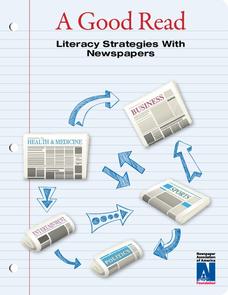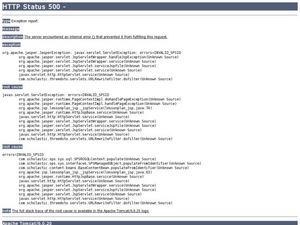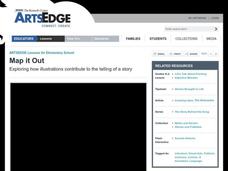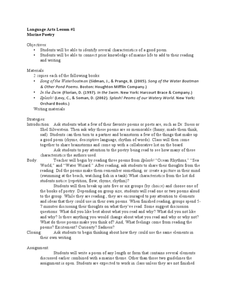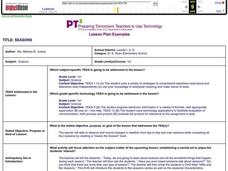Newspaper Association of America
A Good Read
Teach your readers strategies for breaking down informational texts. Pupils develop and implement the tools they'll need to decode texts for the rest of their lives with an informational resource that focuses on the structure and...
Curated OER
Self-Monitoring Strategies and Vocabulary Games
Middle and high schoolers identify how to discover a word's meaning by exploring context clues and any pictures, diagrams, photographs, and charts that might be included. They continue this process with other examples and locate one on...
Curated OER
Reading Comprehension
After listening to a story learners engage in a kinesthetic activity to answer comprehension and critical thinking questions. Finally, the students identify three main facts about the story. Extensions include a fact and opinion...
Curated OER
Newcomers
Explore emotions associated with moving to a new home with young learners. First they listen to the books Painted Words/Spoken Memories by Aliki and Going Home by Eve Bunting. Then they are invited to share their experiences as well as...
Curated OER
Spring-Aloud Read
Students study the season of spring and create stories about the season. In this spring season instructional activity, students read books about spring and discuss the season. Students then color and create a mini-book about Spring.
Curated OER
Child Literacy
Students read information on the importance of literacy and complete a worksheet. In this community service lesson, students evaluate children's literature and practice reading fluency. Students spend two hours per week reading to...
Curated OER
Map It Out
Explore how illustrations add to a story. Young learners will look at picture books to see how the pictures tell the story. They create illustrations to go with a chosen story, and then flip the activity so they have to write a story to...
Curated OER
Getting to Know You
After going over the five steps of the writing process, pupils fill out "Getting to Know You" worksheets. They trade papers with each other, and have the task of writing a descriptive paragraph about the person whose worksheet they...
Curated OER
Poetry and Visualization
Students use visualization techniques when reading poetry. In this visualization and poetry lesson, students work in groups to present a tableau that depicts a word from the poem as classmates guess the word. Students then...
Curated OER
Picture This: Visualization
Sixth graders practice visualizing and understanding that visualization is an important comprehension strategy. They share their visualization of the story through original artwork and determine that ideas, and cultural settings can...
Curated OER
It's Mine Lesson Plan
Students read a book called It's Mine! In this lesson about three frogs and sharing, students explore how what they do affects everything around them. Through a series of seven different activities, students interpret the frogs and their...
Curated OER
Autobiographies: A Jigsaw Puzzle
Students read The Autobiography of Ben Franklin. Using construction paper, they cut out five jigsaw puzzle pieces in different shapes using the entire sheet of paper. They write events from their own lives on the puzzle pieces, thus...
Curated OER
The Fear Place
Students use the strategy turn and talk to discuss inferences they have while reading the book The Fear Place. In this inferences lesson plan, students answer discussion questions and read independently as well.
Curated OER
Charlie and the Chocolate Factory
Fourth graders research and write an author report on Roald Dahl, including books written by him, birthplace, family life, and other information on his writing. Students read aloud chapters in the book. Students create a newspaper...
Curated OER
So You Want to Be President?
Students examine the qualities needed to become President. In this political science lesson, students read the book So You Want to Be President? and answer questions based on the text. Students discuss if they have the qualities...
Curated OER
Found Poems
Students summarize articles found in the newspaper and use key concepts to write a poem. In this reading comprehension and writing lesson plan, students work with a partner to choose a current newspaper article. Key concepts and...
Curated OER
Folktales: "The Storytelling Stone"
Pupils create a folktale after finding out the importance of folktales in different cultures. In this folktales instructional activity, students determine the definition of a folktale and read a "The Storytelling Stone." ...
Curated OER
Around The Town
Students participate in alphabetizing letters, coming up with questions and concepts, and show the rules of phonics by playing a game for a unit opener. In this language arts lesson plan, students also come up with thinking maps.
Curated OER
The Mysterious Tadpole
Second graders examine books written by Steven Kellogg, looking for similarities in his illustrations. They also look at images found on the Internet. They listen to a read aloud of The Mysterious Tadpole up to the point where the eggs...
Curated OER
The Catcher in the Rye: Found Poem Activity
After concluding The Catcher in the Rye class members create a found poem using words drawn from J.D. Salinger’s “Both Parties Concerned.” The story, and directions for crafting a found poem, are included with the resource.
Curated OER
Picture a Character
How would Jean-Etiénne Liotard paint the characters from "The Little Mermaid?" What would the main character from "The Little Match Girl" look like from Francisco José de Goya y Lucientes' point of view? After examining various paintings...
Curated OER
Marine Poetry
Students identify characteristics of good poetry and compose their own. For this marine poetry lesson, students are introduced to several different types of poetry with a marine theme. After discussing the elements...
Curated OER
Seasons
First graders observe and record changes in weather from day to day and over seasons, while comparing all four seasons by creating a "Guess the Season" book.
Curated OER
Charge-Coupled Devices (CCDs)
Students explore CCDs or Charge-Coupled Devices. In this digital devices activity, students examine how CCDs are constructed, collect light, and create a digital signal.
